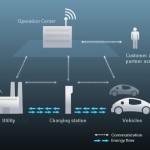 The European Commission has kicked off a 4 year cross-European initiative to promote electromobility.
The European Commission has kicked off a 4 year cross-European initiative to promote electromobility.
The 42 partners in the initiative comprising industrial companies and automobile manufacturers, utilities, municipalities, universities, and technology and research institutions are to input, exchange and expand their know-how and experience in selected regions within Europe.
“Electromobility will make an important contribution toward reducing carbon dioxide emissions. Green eMotion is intended to ensure the fast-track success of electric vehicles,” said Siim Kallas, Vice President of the European Commission and Commissioner responsible for Transport. The project volume has been budgeted at EUR 42 million, of which the EU will contribute as much as EUR 24 million.
The partners in the initiative are to accumulate experience with electromobility in existing and new test regions within Europe and refine the technology. Key issue is the development of European processes, standards and IT solutions that allow customers of electric vehicles easy and seamless access to charging infrastructure and related services throughout the European Union. Standardization is also the key factor for a fast and cost-efficient European rollout of electromobility.
The total number of charging spots within the existing demonstration regions will be more than 10,000, as nearly 1000 are going to be installed in Barcelona, Madrid and Malaga, some 400 in Rome and Pisa, approximately 3600 in Berlin and about 100 in Strasbourg. In Denmark, the country with the world’s largest share of wind-based power generation, car importers expect to put 2,000 electric vehicles on the roads over the course of this year and as many as 2,000 public and semi public charging stations will be installed in Copenhagen, Bornholm and Malmö. Furthermore, some 2,000 electric vehicles and approximately 3,500 charging stations are part of a nation wide rollout in Ireland.
“The local concepts applied to date, in which experience was accumulated in specific demonstration regions, will now be bundled in cross-European trials. The aim is to pave the way for electromobility throughout Europe. This will require standards for infrastructure, networking and IT,” said Heike Barlag from Siemens, who coordinates the Green eMotion project.
“By bundling individual activities in a major partner initiative we’re gaining momentum and transparency, and ensuring the coordinated development of electromobility.” Experience with cars, busses and two-wheelers with pure electric drive systems and as hybrid vehicles is to be gathered in the Green eMotion project. Special aspects in some of the demonstration regions include battery swapping and DC charging as well as smart grid integration, cross-border traffic, different payment systems and the testing of alternative business models.
Siemens is the lead company in the research consortium and contributes to the development of software and charging infrastructure solutions, and to the necessary establishment of industrial standards. “Last year technical development made significant progress.
For example, we’ve already developed charging stations with fast-charge function to market readiness. These will make it possible to charge electric vehicles with a commercially available battery within the space of an hour. In the mid-term we want to cut charging time to less than 15 minutes so that only short charging stops are necessary en route when the battery is empty,” said Ralph Griewing, who is responsible at Siemens Energy for the charging infrastructure for electric vehicles.



